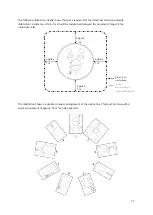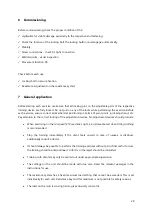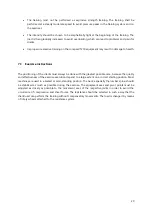
17
3.6
compass
®
210 Trunk Extension/ Flexion
This device trains both the dorsal and ventral trunk muscles.
Specific patient positioning
Adjust the saddle seat according to body height so that a semi-standing sitting position is achieved.
Place the feet symmetrically using the ground marks. Position forearms symmetrically and stably on or
against the upholstered wheels. Use hand grips as needed to facilitate control (not a requirement!).
Stabilize the upper body and shoulder girdle by actively tensing the core muscles.
Initially tense the abdominal muscles before the flexion phase. Under abdominal tension, introduce the
force via the forearm pads and roll the upper body segmentally with the flexion. In the
push phase
extends the upper body with pressure against the roller.
Head control: In the flexion phase, bring the chin slightly towards the chest and "roll" the upper body.
With the push phase the head can be straightened in a controlled way up to the extension of the back.
Perform flexion phase only so far that no hip flexion takes place. Stretch to a maximum of the natural
lumbar lordosis. Always perform movements in a controlled manner, without any swinging movement.
Exhalation coincides with the pull phase. If you have problems in the lumbar spine, exercise very carefully
and slowly.
Stressed musculature
Trunk extension: M. erectores; M. longissimi; M. interspinales
Trunk flexion: M. rectus abdominis; Mm. obliqui abdomini; M.transversus abdominis
Saddle
Ground mark
Cushion
roll
Handle
Back cushion
Hydraulic resistance system
Frame
Summary of Contents for compass 210 Abductor
Page 1: ...compass 210 User manual ...
Page 4: ...4 10 4 Cleaning 35 11 Warranty 36 ...
Page 37: ...37 Notes ...
















































